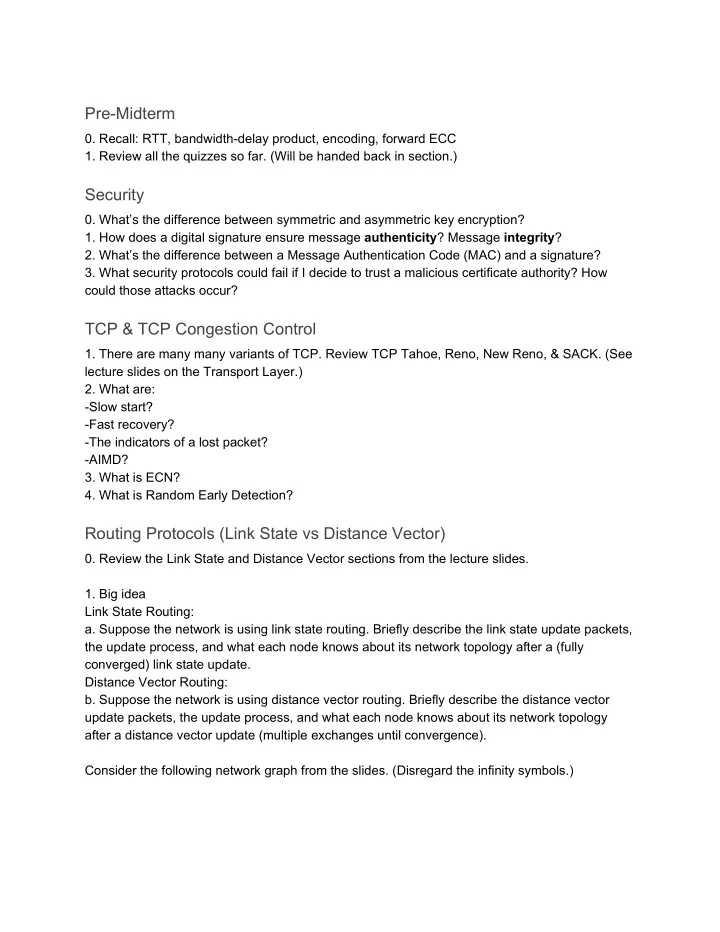

Pre-Midterm 0. Recall: RTT, bandwidth-delay product, encoding, forward ECC 1. Review all the quizzes so far. (Will be handed back in section.) Security 0. What’s the difference between symmetric and asymmetric key encryption? 1. How does a digital signature ensure message authenticity ? Message integrity ? 2. What’s the difference between a Message Authentication Code (MAC) and a signature? 3. What security protocols could fail if I decide to trust a malicious certificate authority? How could those attacks occur? TCP & TCP Congestion Control 1. There are many many variants of TCP. Review TCP Tahoe, Reno, New Reno, & SACK. (See lecture slides on the Transport Layer.) 2. What are: -Slow start? -Fast recovery? -The indicators of a lost packet? -AIMD? 3. What is ECN? 4. What is Random Early Detection? Routing Protocols (Link State vs Distance Vector) 0. Review the Link State and Distance Vector sections from the lecture slides. 1. Big idea Link State Routing: a. Suppose the network is using link state routing. Briefly describe the link state update packets, the update process, and what each node knows about its network topology after a (fully converged) link state update. Distance Vector Routing: b. Suppose the network is using distance vector routing. Briefly describe the distance vector update packets, the update process, and what each node knows about its network topology after a distance vector update (multiple exchanges until convergence). Consider the following network graph from the slides. (Disregard the infinity symbols.)
Back to Link State. 2. Run Dijkstra’s algorithm on the above network topology from the source node G, showing all iterations. 3. Imagine that due to some bug (floating point precision errors? etc), some edge weights are recorded as negative. Would Dijkstra’s algorithm still work? Why or why not? 4. Dealing with failure: a. Now suppose an arbitrary network with average degree d, node number |V| and edge number |E|. A node goes down, and this triggers a link state update. (Note: it does not have to work this way- link state updates can also follow a schedule.) In big O notation, what is the approximate number of messages that get sent out as a result of this update? b. If a node is “flapping” (coming up and going down rapidly) at a rate of once per 30 seconds, give the approximate network bandwidth the updates take up in terms of update message size U bits. c. What would happen if a node claimed to have a path weight of 0 to all of its neighbors? d. What would happen if an update packet was extremely delayed and arrived late? ( stale , as opposed to fresh ) Now Distance Vector . 5. Suppose an arbitrary network with average degree d, node number |V| and edge number |E|. In big O notation, how many messages get sent out as a result of a single distance vector exchange? 6. Dealing with failure: a. Suppose link G-B in the given network graph fails and this triggers an update. How many rounds of distance vector exchange until D’s route to G converges? Assume use of “Split
Horizon, Poison Reverse,” a max hop count of 15, and “hold time” of 10x a single exchange time. b. What would happen if a node claimed to have a path weight of 0 to all of its neighbors? c. What would happen if an exchange packet was extremely delayed and arrived late? HTTP 1. What do the GET and CONNECT methods do? 2. What are the steps for an HTTP request to a server? 3. How does DNS lookup work? 4. What are the protocols used for resolving BGP 1. What are the main components of the protocol? 2. Who are the players? 3. Who and what can each of them announce to? Misc. Protocols 1. What is DNS poisoning? How does it work? (This question is more here for general interest than exam prep- you won’t need to know quite so much detail for the exam.)
Recommend
More recommend